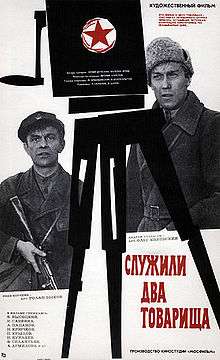Two Comrades Were Serving
| Two Comrades Were Serving | |
|---|---|
 | |
| Directed by | Yevgeni Karelov |
| Written by |
Yuli Dunsky Valeri Frid |
| Starring |
Oleg Yankovsky Rolan Bykov Anatoli Papanov Vladimir Vysotsky |
| Music by | Yevgeni Ptichkin |
| Cinematography |
Mikhail Ardabyevsky Viktor Belokopytov |
| Distributed by |
Mosfilm Creative Union "Comrade" |
Release dates |
|
Running time | 93 min. |
| Country | Soviet Union |
| Language | Russian |
Two Comrades Were Serving (Russian: Служили два товарища, translit. Sluzhili dva tovarishcha) is a 1968 Soviet war film directed by Yevgeni Karelov with a script by Yuli Dunsky and Valeri Frid. The film is about the Russian civil war, in particular, the battle for the Crimean peninsula.
Plot
Two comrades and soldiers of the Red Army, Andrei Nekrasov (O. Yankovsky) and Ivan Karyakin (R. Bykov) were sent by their regimental commander (A. Papanov) on a reconnaissance mission to film the White Army fortifications on the way into Crimea (Perekop). After filming, the engine on their airplane stalled and they were forced to land in unfriendly territory.
As the culmination of a series of misadventures, the friends were going to be executed as spies by their own side. The Colonel appears in time to stop the firing squad.
The second part of the film narrates the assault on Perekop and the Red Army invasion of the Crimea.
The film also features Vladimir Vysotsky as Brusentsov, a cynical and disillusioned officer in Wrangel's Army. He shot Nekrasov down at the end of the film. Karyakin hums his friend's favorite song - "The bullet whizzed and aha!..". Vysotsky's character later shot himself during the evacuation to Constantinople.
The film's focus is the friendship between two decidedly different characters. Nekrasov is intelligent and war-weary, while Karyakin is simple-minded, yet idealistic and energetic.
Cast
- Oleg Yankovsky as Andrei Nekrasov
- Rolan Bykov as Ivan Karyakin
- Anatoli Papanov as Colonel
- Nikolai Kryuchkov
- Alla Demidova as Commissar
- Vladimir Vysotsky as Alexander Brusentsov
- Iya Savvina as Alexandra
- Nikolai Burlyayev
- Pyotr Krylov
- Rostislav Yankovsky
- Roman Tkachuk
- Nikolai Parfyonov
Production
Both screenwriters had been in the Gulags and drew on their experience for much of the dialogue.
The theme song was included on Lubeh's 1995 album, Kombat.